Invisible Cities
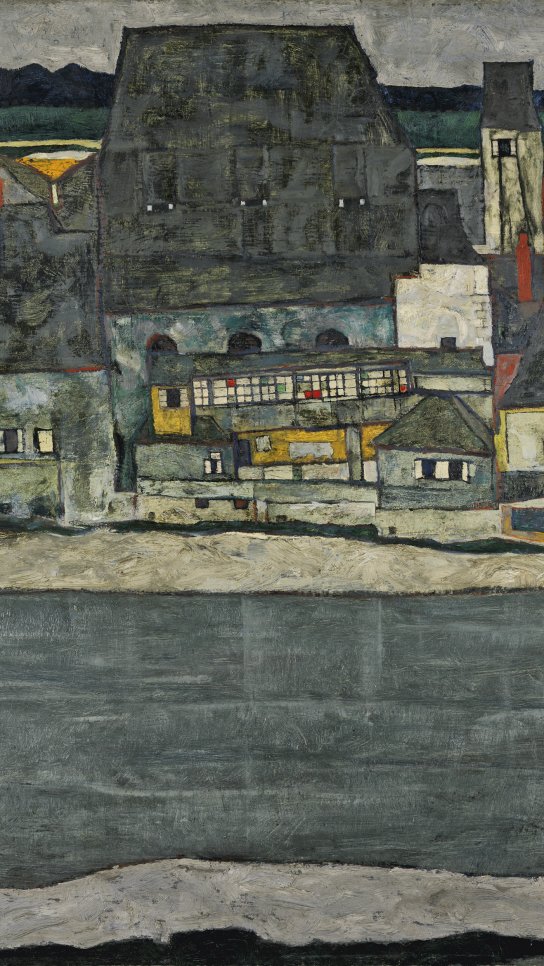
By Ana Gómez and Clara Harguindey
This route adopts the form of a tour of cities represented, imagined and narrated, establishing a dialogue between the novel Invisible Cities (Italy, 1972) by Italo Calvino and selected works in the collection. Like curious travellers, we embark on a journey, an encounter, fleeing through the visible cities at the Museo Thyssen-Bornemisza and creating a dialogue with those imagined by the writer.
Italo Calvino’s Invisible Cities are constructed around the journeys that Marco Polo recounts to the Great Khan. The character of Marco Polo—the thread of the discourse and architect of the imaginary universe of the tales—is inspired by the famous Venetian explorer, who is largely portrayed as a character whose curiosity and thirst to understand “the reasons which bring men to live in cities” make him practically an alter ego in the writer’s quests.
In every city description and every dialogue or reflection, Calvino evokes a timeless idea about the territories and places where we live, developing a poetic yet critical view that questions the contemporary city in a way that closely resembles how artists from every age have done the same with their paintbrushes and canvases.
For Calvino, “Cities are collection of many things: memories, desires, signs of a language; [they] are place of exchange, as all books of economic history explain, but these are not only exchanges of merchandise, but exchanges of words, desires and souvenirs as well.”
Just as a painter sketches a landscape, a territory or the city where his childhood memories were forged, the writer creates his invisible cities as fragments, as a response to different moments in time and questions that he ponders throughout his life. The invisible cities emerged in Calvino’s imagination from a series of files where he collected ideas and notes on the concept of the city, gradually adding more and more pages until they evolved into an entity in themselves, with a common poetics.
This is how I carried on the Invisible Cities book over the years [...] At one stage I could only write about sad cities, and at another only about happy ones. There was one period when I compared the cities to the starry sky, [...]; and another when I kept writing about the garbage which spreads outside the city day by day. In short, what emerged was a sort of diary which kept closely to my moods and reflections: everything ended up being transformed into images of cities—the books I read, the art exhibitions I visited, and discussions with friends.
During our tour we will draw up a map of encounters between the cities described by Calvino and some of the cities painted and imagined by artists in the collection. This will enable us to discover the logics they share, to construct non-visible. As Calvino says, “[It is a space which] the reader must enter, wander round, maybe lose his way in, and then eventually find an exit, or perhaps even several exits, or maybe a way of breaking out on his own.”
Just as the Great Khan only talked to Marco Polo to follow the thread of his reasoning, situating his replies in a discourse already running through his mind, viewers embarking on this route will juxtapose the images in their memory with the images of the cities they encounter on this journey. The idea is to visit the cities in the museum’s collection and focus on the fringes, the secondary narratives, the peripheral concepts. We want to invite viewers to look at these cities in a critical way, to move away from familiar concepts and embrace instead ideas that may initially seem remote or alien. The route is not intended to be conclusive or exhaustive (“[pieces which] seem to evoke ancient cities only make sense insofar as they have been thought out and written with the city of today in mind”) but to encourage us to expand the discourses of the memory, to rethink not “the city” but “our city” and strive to play an active role as agents in the world in which we live, as thinking beings who imagine, invent and create their future.
Starts on the second floor.
On the map you can see the rooms where the masterworks are located.
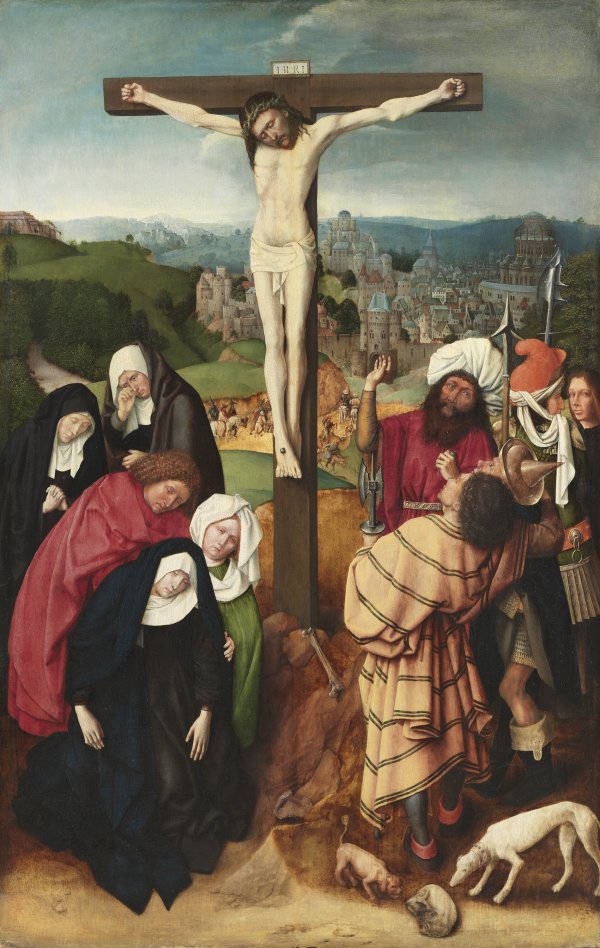
The Crucifixion
Italo Calvino describes clarice as a city being endlessly rebuilt by the passage of time, historical events and resettlements: “Put together with odd bits of the useless Clarice, a survivor’s Clarice was taking shape […] The days of poverty were followed by more joyous times: a sumptuous butterfly-Clarice emerged from the beggared chrysalis-Clarice. The new abundance made the city overflow with new materials, buildings, objects.”
In this canvas the Dutch painter Gerard David recreates a city as the backdrop to the biblical scene represented in the foreground: the lamentation over the dead body of Christ on the cross. The grief of the people who accompany Jesus in his dying moments is shown through their gestures and how they hold their body. They form a compositional parenthesis framed by the city in the background: an imaginary reconstruction of the medieval city—specifically, Jerusalem—with its walled layout, intertwining streets and a vital rhythm that persists in spite of the episode narrated in the foreground. The city’s appearance is in keeping with the typical urban planning of the Middle Ages and is dominated by a large circular temple, crowned by a dome, and a castle on the highest point of the land. As the heart of medieval Christendom, Jerusalem became a benchmark city, a model, a site of pilgrimage, and a place of convergence and divergence. Gerard David takes a number of artistic licences in his representation of the city. Familiar with the descriptions passed down through the Chronicles of the Crusades and travel books, the artist imagines a city in which the architectural aesthetics of the buildings recall the Flemish cities where he lived, with their characteristic stepped facades and Gothic features, a Jerusalem that takes shape through the cities he experienced personally.
It is interesting to observe the sensation of urban agglomeration and continuity in the layout of a city that seems to be bursting at the seams, all the available space already taken up—a common phenomenon in these types of urban environments where resettlements and expansion burgeoned or declined depending on the moment, be it a time of war, epidemic or new conquest, and which, like the description of Clarice, led to the transformation of the city: “Populations and customs have changed several times; the name, the site and the objects hardest to break remain. Each new Clarice, compact as a living body with its smells and its breath, shows off, like a gem, what remains of the ancient Clarices, fragmentary and dead.”
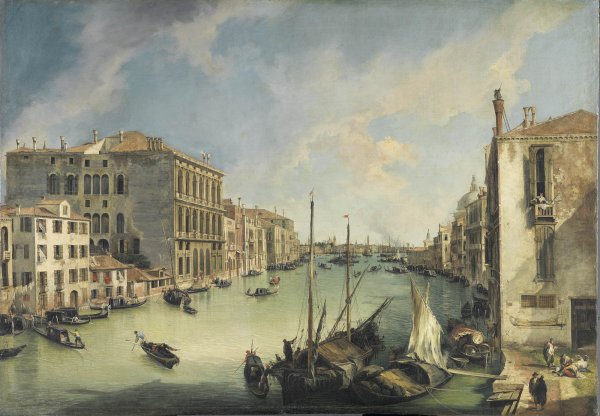
The Grand Canal from San Vio, Venice
As in Esmeralda, which Calvino describes as a “city of water, a network of canals and a network of streets [that] span and intersect each other [...] a zigzag [...] combining segments of the various routes, elevated or on ground level [...] the most fixed and calm lives are spent without any repetition”, it is the web of crossings, bridges and canals that forms the backdrop to much of the life and work of Antonio Canal, “Canaletto”, the Venetian painter who echoed Calvino words: “Every time I describe a city I am saying something about Venice.”
The son of Bernardo Canal, a theatrical scene painter, and an admirer of vedute and architectural caprices, popular genres during the 18th century, Canaletto projects a view of Venice that is founded on certain creative freedoms and licences, reinventing it and creating an imagined city. In Invisible Cities, Calvino says that his cities cannot be measured with reason or objectively; rather, they are the same feelings and desires of their inhabitants that are awakened as they stroll through them.
This view of The Grand Canal from San Vío and the The Piazza San Marcos in Venice are among the earliest vedute painted by the artist. Canaletto depicts the waters of the canal teeming with gondolas and other vessels, the buildings and the iconic architecture of the city built on the lagoon: the palaces, the churches with their domes and artistic ornaments... But he also includes its inhabitants, like the woman leaning out of a window of the Palazzo Barbarigo and the man cleaning one of the chimneys, through whom he introduces visual anecdote.
Canaletto’s Venetian views are not a photographic or objective representation of reality but are filled with evocations. The artist creates his own setting. He invents another Venice, often based on sketches from life but with modifications in the perspectives, using elevated viewpoints and altering the arrangement of the buildings and the colours of the details. To animate the imaginary, secret life of the city, he adds figures engaged in ordinary activities. However, such was the degree of authenticity achieved that even the painter’s contemporaries had difficulty separating the real city from the fictions recreated by the artist.
Venice boasted all the ingredients for becoming one of the most portrayed cities of all times: a highly visible oriental legacy dating from the early Middle Ages, Byzantine domes, gilded mosaics, richly coloured textiles mixed with an interpretation of oriental features in the Gothic forms, and all of this alongside the scientific rigour of Renaissance architecture and Baroque optical illusions. Meetings of different influences and aesthetics which, like the city itself, are reflected in the waters of the lagoon, as if it were a mirror, creating a dual image of the city that resembles Calvino’s Valdrada: “The ancients built Valdrada on the shores of a lake, with houses all verandas one above the other, and high streets whose railed parapets look out over the water. Thus the traveller, arriving, sees two cities: one erect above the lake, and the other reflected, upside down.”
The rich artistic qualities of a city like Venice also recall the city of Phyllis, which Calvino places in the “Cities and Eyes” category, places whose visual beauty overwhelms the senses. “When you have arrived at Phyllis, you rejoice in observing all the bridges over the canals, each different from the others: cambered, covered, on pillars, on barges, suspended, with tracery balustrades. And what a variety of windows looks down on the streets: mullioned, Moorish, lancet, pointed, surmounted by lunettes or stained-glass roses; how many kinds of pavement cover the ground: cobbles, slabs, gravel, blue and white tiles. At every point the city offers surprises to your view.” Besides, Phyllis is also one of those cities “which elude the gaze of all, except the man who catches them by surprise”.
This desire to recreate the ideal city has long accompanied and fuelled the legend of the city of Venice. Views or vedute of the city were greatly appreciated and admired by the British travellers of the 18th century on their grand tour of Italy. Canaletto enjoyed enormous prestige as well as a considerable clientele who purchased these canvases as painted souvenirs of the city. In part, the Invisible Cities are a reflection of dreams and idealised visions. When he describes Fedora, Calvino imagines a city reinventing itself, in search of its most utopian version. The big stone Fedora coexists with the little Fedoras preserved in glass globes, each of them in one of the rooms in the palace that presides over the city. “In every age someone, looking at Fedora as it was, imagined a way of making it the ideal city, but while he constructed his miniature model, Fedora was already no longer the same as before, and what had been until yesterday a possible future became only a toy in a glass globe.”
We bid farewell to Venice remembering the words of Marco Polo when he expresses his fear at forgetting the city through whose recollection he imagines every one of the cities he describes: “Memory’s images, once they are fixed in words, are erased. Perhaps I am afraid of losing Venice all at once, if I speak of it. Or perhaps, speaking of other cities, I have already lost it, little by little.”
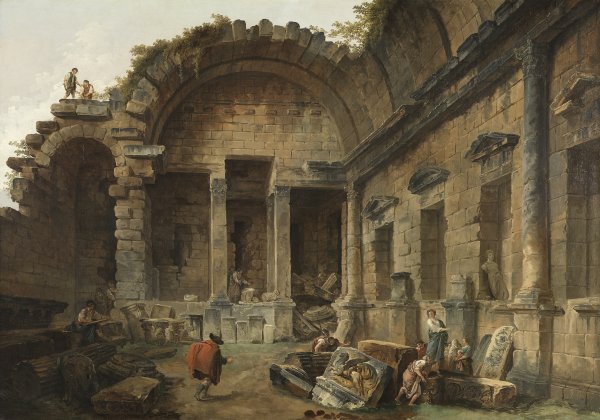
Interior of the Temple of Diana at Nimes
Are cities containers of memory? do we associate memories with our cities so that, in some way, they transform our experience of them? These are some of the questions around which Italo Calvino articulated the five descriptions of his cities and memory, one of the eleven categories of cities into which the book is divided.
Diomira, Isidora, Zaira, Zora and Maurilia make up this little universe of places where recollections and the memory of past events create maps of relationships and spaces through which to wander. In all five, our perception is transformed by experiences and by real and imagined events. Strolling through their avenues arouses in the reader a feeling of nostalgia for the uncertainty that emerges when a memory is lost and the past falls into oblivion.
From a young age, Hubert Robert, nicknamed “Robert des ruines” because of his interest in drawing and painting architecture and archaeological remains, became increasingly fascinated with archaeology and ancient monuments as part of the Enlightenment philosophy. He started by making sketches, taking notes and practising during his travels to Italy, where he had the opportunity of meeting grand masters of vedute of Rome like Giovanni Paolo Panini, who together with Giovanni Battista Piranesi would inspire much of his work.
In Interior of the Temple of Diana at Nîmes, we see the remains of a building in ruins. Most of its vaulted roof has been lost, while columns, statues, pedestals, lintels, fragments of reliefs and other architectural elements are scattered in pieces across the floor where a series of figures have gathered to study, draw, poke around and admire the preserved remains. They are caught up in a similar experience to that which befalls the traveller when he comes upon the dreamed-of city of Isidora that Calvino describes as the place he arrives at “in his old age”, where “desires are already memories”.
In Calvino’s cities, as in Hubert Robert’s paintings, strolling and touring the streets and buildings produces a sensation of loss and mirage before beauty about to be forgotten. This is achieved by constructing a universe of images around a combination of classical elements and invented, less real ones. Some of these, as with Calvino, even have a fantastical quality. Silver domes, bronze statues of fabulous creatures, palaces with spiral staircases embedded with conches and glass theatres are examples of the urban elements that populate some of these cities.
Hubert Robert’s works produce a similar experience to the one described by Calvino in the case of Maurilia. There are cities in which we want to relive the past, the memory of a civilisation and bygone ages. When the traveller visits the city of Maurilia, he is invited at the same time to examine old postcards that show it as it used to be, so that he can compare the past city with the present-day one. This is a way of understanding the passage of time over spaces and the things they witnessed. But, as in this case, it also makes us ask ourselves whether we are capable of reliving both versions or whether, as Calvino concludes, each of the cities, the past one and the present one, are different entities, which makes him ponder the relationship between them and the possibility of reinterpreting one based on the other.
Continues on the fisrt floor
On the map you can see the rooms where the masterworks are located.
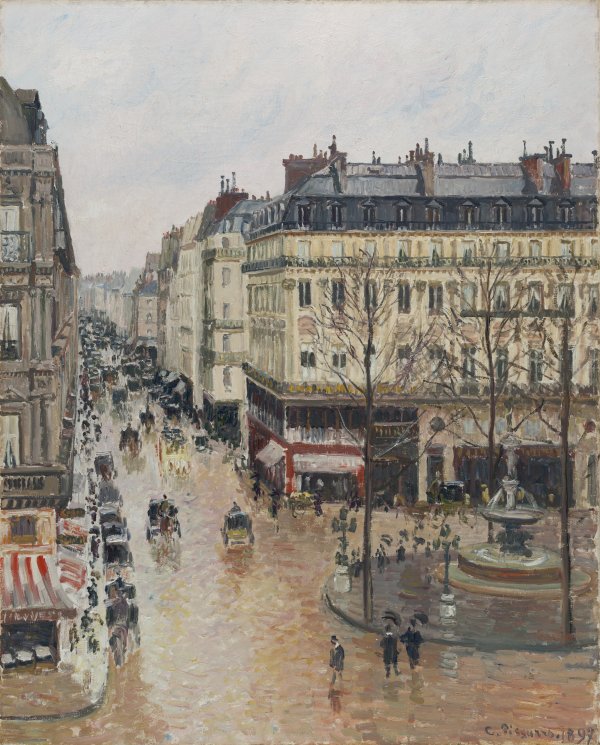
Rue Saint-Honoré in the Afternoon. Effect of Rain
A member of a well-to-do family of Jewish descent, the French painter Camille Pissarro decided to leave the Danish West Indies island of St Thomas, against his father’s wishes, to take up painting in Paris.
After several trips between his native city and Venezuela, he finally returned and settled in Paris in 1855, exhibiting for the first time at the Salon in 1859. That year he met Claude Monet, Auguste Renoir and Alfred Sisley. The painter believed that collaboration between artists was very important, and he played a pivotal role in holding together the Paris Impressionist group. In 1870 he stopped participating in official exhibitions due to their strict principles, which clashed with his anarchist political leanings.
From 1866 onwards (most of his life) he lived outside Paris and is known to have mainly painted landscapes and country scenes. He was also a fervent practitioner of plein air painting. However, because of his failing eye sight he had to return to the city, and it was then that he started painting what he saw through the window. Rue Saint-Honoré in the Afternoon. Effect of Rain is one of a series of 15 paintings that he produced of the views from his room. He reworked this particular painting at different times of the day, so while this one corresponds to the early afternoon light there are day-time and night-time versions as well.
The painting belongs to the set of works which the artist produced in the last decade of his life, when he returned to the Impressionist style after a brief period experimenting with Pointillism, under the influence of Seurat. It is no coincidence that he abandoned this extremely rigid technique when his anarchist leanings became more radical.
Unlike the rural landscapes, in which the artist paints as if one with the landscape, looking on it (as we do) from close up, here he approaches the city from the distance of one who looks without being seen. In this way, Pissarro invites us to observe and build with our gaze.
The city of Paris is foreshortened; the diagonal line of the street, interrupted by the vertical figures of trees and street lamps, blurs like a mirage at the vanishing point. The people, of different social classes, are individualised rather than being drawn as a mass. The wide Parisian boulevards and the transformation ushered in by Haussman’s urban renewal provide the backdrop for a modern society in a city where the art scene is springing to life and the bourgeoisie are exhibited in all their splendour. This is the Paris which decades later, during the interwar period, after the Nazi occupations and historical vicissitudes, would turn its back on some of these vibrant, modern spaces of the early 20th-century, as Walter Benjamin noted when he spoke of the Parisian landscapes that had evolved from busy quarters teeming with arcades and spaces of gathering into “a type of shelter that one remembers when it rains ”.2
Perhaps in painting the city after working repeatedly on rural landscapes, Pissarro asked himself the same question that Marco Polo pondered about Zoe: “Why, then, does the city exist? What line separates the inside from the outside, the rumble of wheels from howl of wolves?”
Faithful to his political ideas, the artist conceived of the rural world as a harmonious model of life. Playing the role of flâneur described by Baudelaire, a stroller in search of the extraordinary and unexpected encounters, he takes a step back and shows us city life, inviting us to look and reflect on it.
Casting our gaze along Pissarro’s Parisian boulevards, the sensation is similar to that described by Calvino when he talks about the city of Aglaura, in which “at certain hours, in certain places along the street, you see opening before you the hint of something unmistakable, rare, perhaps magnificent; you would like to say what it is, but everything previous said of Aglaura imprisons your words and obliges you to repeat rather than say.”
2 Excerpt from Walter Benjamin’s work.
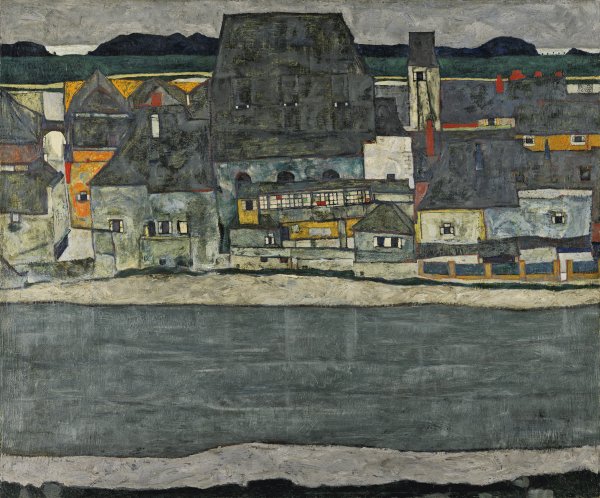
Houses on the River (The Old Town)
Schiele was the leading figure of austrian Expressionism. He believed that art could not be “modern” because art was primordially eternal. However, he did believe in the existence of “new artists” because along with other young artists of his generation he founded the Neukunstgruppe. The group’s manifesto, written by Schiele himself, defended the individuality of the artist and the “ego” as the sole basis of the artwork, over and above any external reference.
It is therefore hardly surprising that the group split up after a short time.
Schiele’s work centred on representing human bodies, through self-portraits and themes related to sexuality. This focus led to him being imprisoned for 24 days in 1912, when he was just 22 years old, after the police found 125 portraits of nudes at his home.
In addition to bodies, urban landscapes are also present in his work. One such is Houses on the River (Old Town), in which he represents Krumau, a little town on the banks of the River Moldava in Bohemia, where his mother was born.
Tired of living in Vienna, where we know from his letters that people envied him and rebuked him constantly for his moral conduct, Schiele decided to go and live in this conservative town. The idyllic existence of his fantasies never materialised, and soon after his arrival he was expelled due to his libertine lifestyle. Schiele was horrified by the wartime atmosphere of this period.
In addition to his viewpoint, which lacks perspective, and a composition reminiscent of Gothic stained-glass windows and miniatures, Schiele took numerous licences in drawing the city, inserting and eliminating some of its characteristic features. This contradictory sentiment regarding the city recalls Calvino’s description of Adelma, when he says: “Perhaps Adelma is the city where you arrive dying and where each finds again the people he has known.” Schiele inhabited an anxiety-ridden reality that he found hard to understand. He said he had the misfortune of living through the most terrible times ever experienced by humanity, and that in such a situation all that remained was to accept one’s fate, living or dying, and to look to the future, for anyone who lost hope already belonged to the world of the dead.
We perceive that anguish in this work, that sense of unease provoked by the empty city, the city without hope, the moribund city which, from the moment of birth, already contains and announces the moment of its demise, just as Calvino writes about one of his cities: “From my words you will have reached the conclusion that the real Berenice is a temporal succession of different cities, alternately just and unjust. But what I wanted to warn you about is something else: all the future Berenices are already present in this instant, wrapped one within the other, confined, crammed, extricable.”
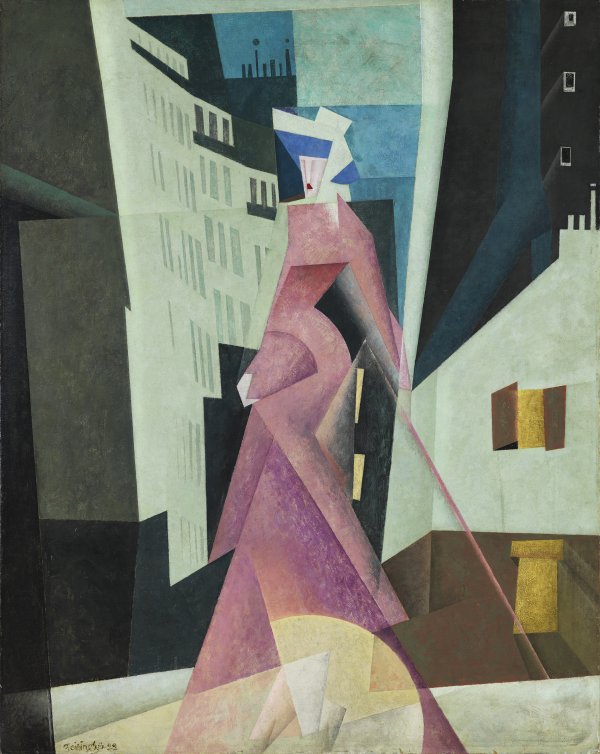
The Lady in Mauve
Feininger painted the lady in mauve at the beginning of the 1920s while working as a teacher and running the print workshop at the Bauhaus (Weimar, Germany), where he stayed until it closed in 1932. In this scene—akin in theme and timeline to the work Architecture II (The Man from Potin), also in the collection and with which it may have formed a pair—Feininger projects his memories and imagination associated with the years he spent in Paris. On this occasion he portrays a woman strolling though the city streets. She is represented from a low viewpoint, creating the sensation of a larger scale that enables the figure to almost touch the rooftops and sky over the city. For the creation of this work, the artist makes use of a drawing entitled La Belle, from his Parisian years, which features the same motif: a strolling woman viewed from behind, her torso slightly turned towards us, again from a low viewpoint and framed by the city buildings she encounters on her way.
Sixteen years later, the dream and memory of this figure fuse with his new artistic quests, based on much freer effects in terms of spatial representation and the broken perspective as well as experimentation with form and the use of colour. Feininger shuns the more organic lines of the first drawing and opts instead for a composition that explores geometry and fragmented, angular forms in a division of planes that reveals the aesthetic influences of Cubism and Futurism.
The scene evokes the aura of a dream state, of a moment remembered and encapsulated in the memory. The city of Zobeide described by Calvino also seems to be the fruit of a dream or recollection: “Men of various nations had an identical dream. They saw a woman running at night through an unknown city; she was seen from behind, with long hair, and she was naked. They dreamed of pursuing her.” After the dream takes place, the city is rebuilt and the streets laid out again day after day through the desire to relive the experience. Like Feininger’s Parisian memories, the city of Zobeide bears witness to the endurance and strength of the memories that shape our experience of the cities and the spaces where we live.
Feininger was fascinated with the lights of the big city as a young child, both in his childhood strolls through a New York in constant expansion and vertical unfolding as well as in the discovery of cities like Paris and Berlin. Streets, buildings and passers-by are recurring themes in the artist’s work. The cities he experienced and dreamed about were materialised in the creation of The City at the Edge of the World, a project through which he reinvented the idea of the small-scale city: an imaginary universe built out of fragments of painted wood carvings, populated with houses, trains, boats, bridges and toy constructions on which he worked for decades, evolving from softer, figurative forms to increasingly expressionist, visionary characters and tiny sculptures imbued with the feelings of loss and desolation caused by the wars and the artist’s personal development.
If Feininger articulated his “city at the edge of the world” as a vehicle for projecting his personal history, dreams and questions about his experience as the inhabitant of a city and a crumbling world, those who dreamed of and then arrived at Zobeide “decided to build a city like the one in the dream. In laying out the streets, each followed the course of his pursuit; at the spot where they had lost the fugitive’s trail, they arranged spaces and walls differently from the the dream, so she would be unable to escape again”, and in those streets they waited for a scene that in all probability would never be repeated in the dream.
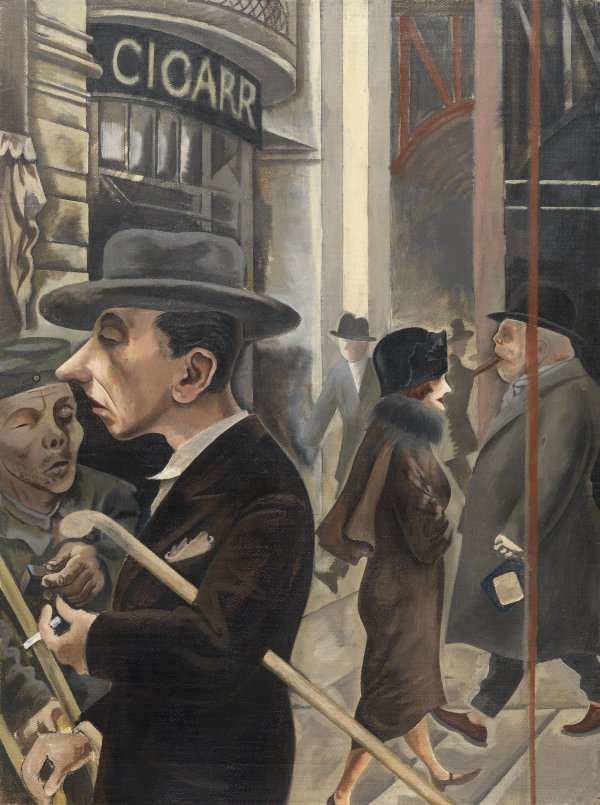
Street Scene (Kurfürstendamm)
Street scene (kurfürstendamm) by George Grosz shows us a view, a glimpse of a Berlin street after the chaos of the years that followed the end of the Great War. The shop windows, buildings and urban furniture, built out of new materials like steel, iron and glass, in keeping the modern city, serve to frame the figures that populate the scene. We see them close up but, like them, we are unable to engage in dialogue or connect with them in any way. The figures move in different directions, absent-mindedly, lost in their own thoughts and circumstances. Their eyes cast downwards, fixed on the ground, they explore the city by digging it with their eyes, as occurs in the city of Zemrude. We even have the sensation that they would change cities if they could, constantly moving from one to another; to repeat the same actions, “they open alternate mouths in identical yawns”, like the people of Eutropia, made up of many cities with the same layout, repeated ad infinitum.
With his critical gaze and acute sense of observation, George Grosz presents us with the scenario of empty human relationships and social inequalities that characterised Germany during the Weimar Republic. Grosz is known as a painter of cities and their people, which he sketches, caricatures and questions. One of the most prominent figures in this picture is the bourgeois woman with the pale face, hat and fur coat; another is the man in the foreground, cigarette in hand and a walking stick hanging from his arm. Meanwhile, a war cripple with a crutch, his face ravaged by the consequences of the war, seems to address the man but obtains no reply. Faces and bodies portrayed in a way that verges on caricature reveal a more objective style and critical gaze that are akin to the social denunciation associated with the new pictorial trend known as New Objectivity, which Grosz embraced during the 1920s along with other German artists, eschewing the more incendiary and apocalyptic visions of the Expressionist cities he created during the war years.
Italo Calvino also ponders the way we live and relate to others in modern cities. The people we find in the descriptions of his cities stroll, observe, wait, dream and engage in certain actions, but they rarely speak or establish contact with one another. In the city of Chloe, “the people who move through the streets are all strangers. At each encounter, they imagine a thousand things about one another; meetings which could take place between them, conversations, surprises, caresses, bites. But no one greets anyone; eyes lock for a second, then dart away, seeking other eyes, never stopping.” The inhabitants of Chloe, like those portrayed by Grosz, show us the fragility of human relationships and recall the concept of “liquid modernity” which Zygmunt Bauman uses, through the metaphor of liquidity, to define the precarious nature of human bonds in a society marked by the transient, volatile relationships of the modern world. About the inhabitants of Chloe, Calvino concludes: “If men and women began to live their ephemeral dreams, every phantom would become a person with whom to begin a story of pursuits, pretences, misunderstandings, clashes, oppressions, and the carousel of fantasies would stop.”
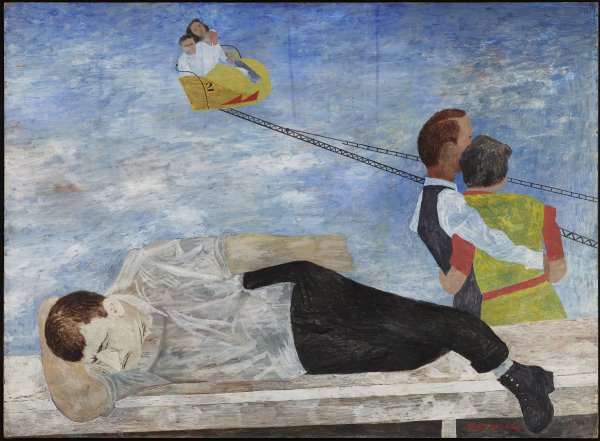
Carnival
Ben Shahn was one of the leading figures of American social realism. As much a photographer as a painter, he often combined both art forms, using his photographs as a reference for his paintings. Carnival is a case in point.
The image of the funfair stall holder asleep on the counter of a target shooting stall, juxtaposed with the portrait of a couple enjoying the delights of the fair, generates the starting point for telling a different story. Like Hypatia, where “signs form a language, but not the one you think you know”. The stallholder becomes a visitor who sleeps and dreams, and the couple no longer inhabit the real world but his dream. “It is the mood of the beholder which gives the city of Zemrude its form.” Shahn manages to create an atmosphere of unreality by stripping the elements in the scene of all superfluous detail. Based on photographs that possibly captured a festive day, full of noise and excitement, the artist composes a space of loneliness and desire. Like Despina, where “each city receives its form from the desert it opposes; and so the camel driver and the sailor see Despina, a border city between two deserts”.
The desert evoked in this work is the loneliness of a man who longs to be part of a couple. That aspiration to love and be loved reminds us of Anastasia: “The city appears to you as a whole where no desire is lost and of which you are a part, and since it enjoys everything you do not enjoy, you can do nothing but inhabit this desire and be content. [...] your labour which gives form to desire takes from desire its form, and you believe you are enjoying Anastasia wholly when you are only its slave.”
We therefore observe that what our eyes see on encountering this work is the reality built by the artist’s gaze (which is desire). And we understand his own story, which recalls the words of Marco Polo: “Yes, the empire is sick, and, what is worse, it is trying to become accustomed to its sores. This is the aim of my explorations: examining the traces of happiness still to be glimpsed, I gauge its short supply. If you want to know how much darkness there is around you, you must sharpen your eyes, peering at the faint lights in the distance.”
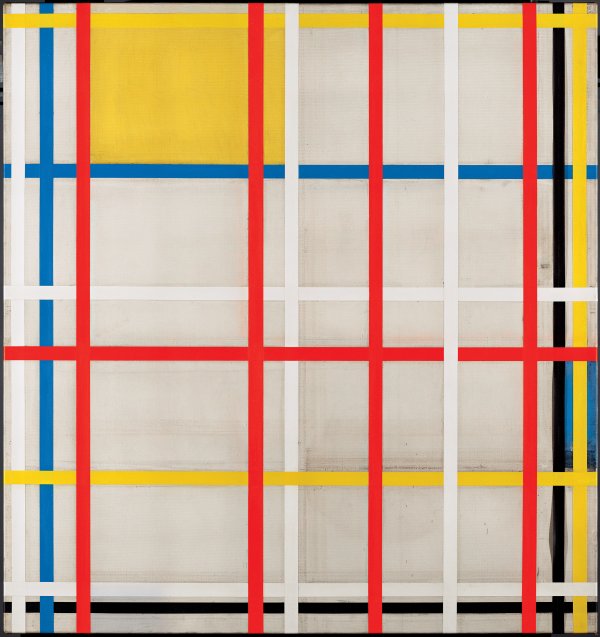
New York City, 3 (unfinished)
In 1940 Piet Mondrian moved to the city of New York, leaving behind a Europe ravaged by war, with Nazis advancing on Paris and the air raids falling over London.
The formal experiments carried out in the Netherlands with the De Stijl collective, formed by artists and architects who created a new language of artistic representation that was more universal, refined and simple, sought to break away from portraying reality as we see it and explore the new territories of geometric abstraction through the lessons learned from the Cubist works.
These experiments, which combined the disciplines of painting, architecture and design, gave rise to a semantic universe in which the straight line and primary colours became the medium for representing harmony and universal order.
After settling in New York, Mondrian continued to evolve his language. Compositions like New York City, 3 (unfinished), which are structured around straight vertical and horizontal lines that intersect and form overlapping grids, exemplify the new dialogues and influences that the city brought to his work. Fascinated with Manhattan’s urban layout, spatial distribution, skyscrapers and dynamic life, Mondrian developed a series of canvases which all clearly convey the idea of process, the interplay of formal tensions between line, colour and texture, and the dialogue with the city.
A characteristic feature of these New York works is the introduction of coloured adhesive tape as a new experimental and reversible material that enabled him to modify the composition until
he achieved the desired result, creating endless possibilities. Some of these works, like New York City, 3, reveal that suspended stage of the creative process and are therefore considered to be unfinished.
In the city of Esmeralda, the streets intertwine, offering numerous combinations and possible routes. Calvino suggests: “A map of Esmeralda should include, marked in different coloured inks, all these routes, solid and liquid, evident and hidden.” Those paths that the inhabitants take each day to avoid boredom, creating new ways of connecting two points of the city: the cats wandering over the rooftops, the illicit lovers strolling, even the “routes of the swallows, who cut the air over the roofs, dropping long invisible parabolas with their still wings, darting to gulp a mosquito, spiralling upwards, grazing a pinnacle, dominating from every point of their airy paths all the points of the city.” Like the New York imagined by Mondrian, the city of Eudoxia is laid out “in symmetrical motives whose patterns are repeated along straight and circular lines, interwoven with brilliantly coloured spires, in a repetition that can be followed in the whole woof. But if you pause and examine it carefully, you become convinced that each place in the carpet corresponds to a place in the city and all the things contained in the city are included in the design”.
Maps that represent cities; canvases that capture the to-ing and fro-ing of urban life and its spaces; combinations that weave networks of possible connections and dialogues within the problems that beset the expanded city... Calvino talks about all of these in his description of the city of Ersilia where, to create the relationships they establish with the city’s life, the inhabitants stretch strings between the corners, windows and angles of the houses, and “when the strings become so numerous that you can no longer pass among them, the inhabitants leave: the houses are dismantled; only the strings and their supports remain”.
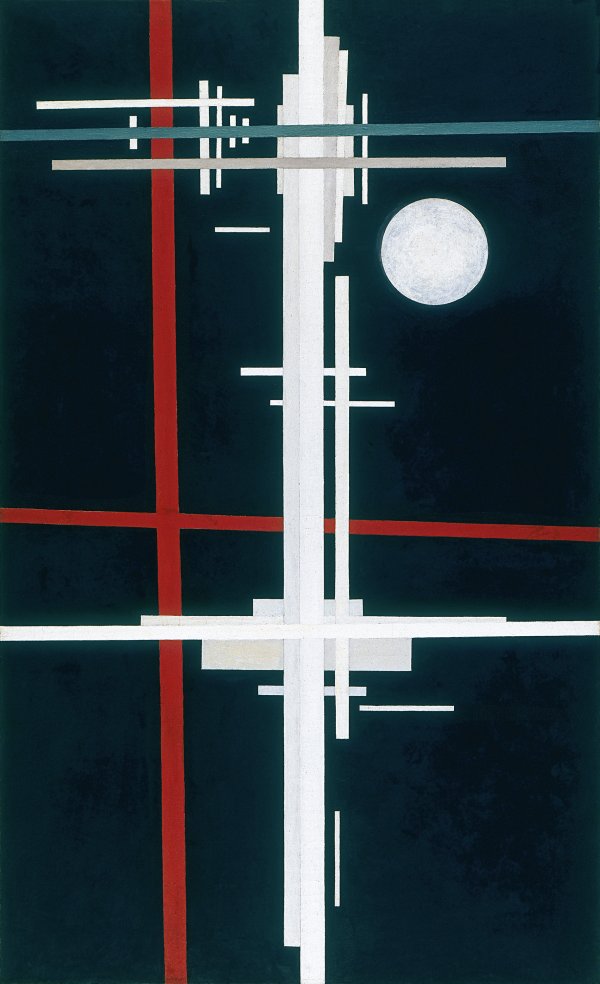
Suprematist Composition
In the early decades of the 20th century, imperial Russia (soon to become the Soviet Union) underwent a major social transformation and numerous avant-garde movements emerged on the art scene. At that time, Ilya Chashnik, interested in the work and poetics of Marc Chagall, was a student at the Vitebsk Art School. It was there that he met Malevich and became his disciple, radically altering the style of his work to embrace Suprematism. He and a few other students also formed the group known as Unovis (Affirmers of the New Art).
For the Suprematists, the continual depiction of reality, the illustration of customs and the virtuosity of figurative representation held no value. They believed that feeling, trapped in a tangled web of symbols that alluded to the objective and countable, had been exterminated. Feeling, like the city of Zora “forced to remain motionless and always the same, in order to be more easily remembered [...] has languished, disintegrated, disappeared. The earth has forgotten her”. The Suprematists’ real ambition was not to reproduce objective elements of reality as accurately as possible but to capture feeling, and they believed that art had been trapped by “the dictatorship of a method of representation”. As their manifesto states, they believed that until the advent of Suprematism art was rooted in the “beloved likeness of reality, true objectivity and a spiritual feeling".
Suprematism shunned this objectivity and reference points, striving instead to confront us with pure feeling. Thus, in this work, of which there are several versions, Chashnik constructs a series of geometric figures that form a type of subtle, abstract, airy and weightless city. Like Lalage, it “grows in lightness”, and although we should not look for anything figurative in it, we can imagine this composition to be that city where “from a distance the spires of a city rise slender pinnacles, made in such a way that the moon in her journey can rest now on one, now on another, or sway from the cables of the cranes”. However, we will not find any objectivities to seize upon, we will only encounter feeling, which might be like that city of which Marco Polo says: “The traveller directed towards Baucis cannot see the city and yet he has arrived.” The Suprematists would inhabit Baucis, and not nature or its representation, but a desert stripped bare of all references and allusions to reality, and they would contemplate with fascination “their own absence”, avoiding the creation of new objectivities or practical concepts, fleeing from the construction of “cities to convincing to be true”.
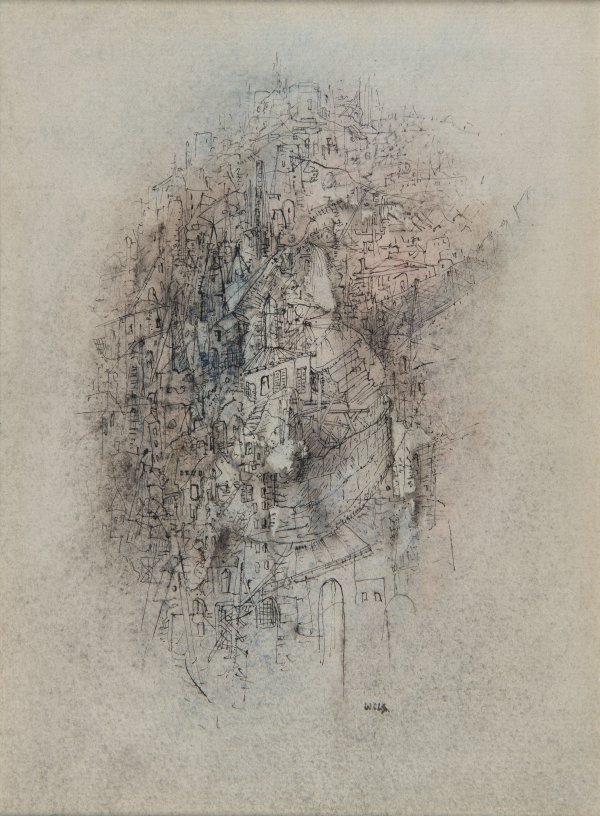
The City
Sartre said of Wolfgang Schulze, the artist known as Wols, that he tried to “see the Earth with inhuman eyes”.
The artist left Berlin in 1933 following the rise of Nazism. When World War Two broke out, he was interned in a concentration camp and was later forced to flee from the advance of the German troops. He spent his short life (he died at the age of 38) between Germany, France and Spain, always living on the fringes of society, a society broken by destruction and totalitarianism.
His work defines the trend known as Tachisme, part of the Art Informel movement of that period. Morally dejected, disconcerted and disillusioned with the collective utopias, Wols and the artists of his generation believed in individualism as a last place of refuge. Subjectivity, expressed in abstract, immediate forms and the use of different materials, was the means through which they represented and analysed reality.
Wols combined abstraction and figuration in his work, a trend known as “art of another kind”. This juxtaposition of languages forms part of his vision of the world, which oscillates between Taoist philosophy and its aspirations of harmony with nature and existentialism, between improvisation and premeditation, between beauty and ugliness, between built and broken.
The City, blurred and draw randomly and impulsively, in a frenzied manner, is painted with a mixture of techniques (gouache, India ink and watercolour). The drips and lines create the effect of a spider’s web, like the city of Octavia: “Below there is nothing for hundreds and hundreds of feet: a few clouds glide past; farther down you can glimpse the chasm’s bed.”
Wols’s tangled city seems light and suffocating. Devoid of human life, it seems to have a life of its own, as if it had swallowed up the inhabitants.
This labyrinthine sensation, painted from the entrails, reminds us of Argia: “We do not know if the inhabitants can move about the city, widening the worm tunnels and the crevices where roots twist: the dampness destroys people’s bodies and they have scant strength; everyone is better off remaining still, prone; anyway, it is dark.”
This city speaks of grief, devastation, the abyss. Of Wols’s Europe, where it no longer makes sense to define oneself as happy or unhappy. As they say of Zenobia: “It makes no sense to divide cities into these two species, but rather into another two: those that through the years and the changes continue to give their form to desires, and those in which desires either erase the city or are erased by it.”
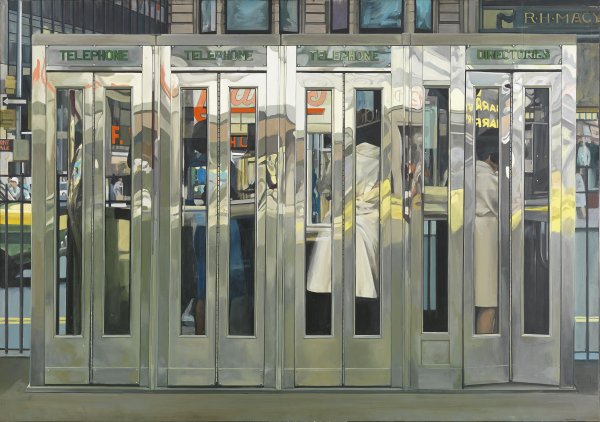
Telephone Booths
Beneath the photorealism of Estes’s work is a complex, confused city; an imaginary vision, a deceptive reality. The work combines a series of photographs of New York telephone booths taken by the artist.
Focusing our gaze on the composition, we find glass windows that act as mirrors, we find what look like mirrors but aren’t, and we see recognisable reflections mixed with confusing ones; signs that our mind insists on interpreting. Estes examines the city in great depth: the reflective surfaces, the transparencies, the warped images and the distorted reflections that accompany passers-by on their way. He trains his camera and critical gaze on the objective sharpness of these images and crystalline messages, capturing them with greater precision than the naked eye, like the “thick coating of signs” in the city of Tamara, where it is virtually impossible to discover what is contained or concealed. Thus, dazed by the disfigured surfaces of the telephone booths and the dramatic photorealist effect, we believe that what we see is the truth but it isn’t. We are witnessing a discourse of reality in which “the eye does not see things but images of things that mean other things”, where the “gaze scans the streets as if they were written pages: the city says everything you must think, makes you repeat her discourse, and while you believe you are visiting Tamara [or in this case, New York], you are only recording the names with which she defines herself and all her parts”. We recognise the buildings that rise up behind the booths (the department stores Macy’s and Woolworth’s), we see a yellow cab go by and the people with their backs turned to us, and although we don’t know and never will know what they’re talking about, if we try hard enough we can guess. We imagine that we’re listening to them and we hear the sounds of the city, because although we may never have strolled along the streets of New York, “each man bears in his mind a city made only of differences”; for Westerners, New York is an invisible city, imagined a thousand times and in a thousand different ways.
The realism in this work does not aim to give us answers but to ask questions. It makes us uneasy, it invites us to understand incomprehensible signs. Since “there is no language without deceit”, we must all find and avoid the trap, the city’s great lie, and project our own truths on it; we must strive to cast our critical gaze over this city made of signs until we finally see our own distorted reflection in the booths.
